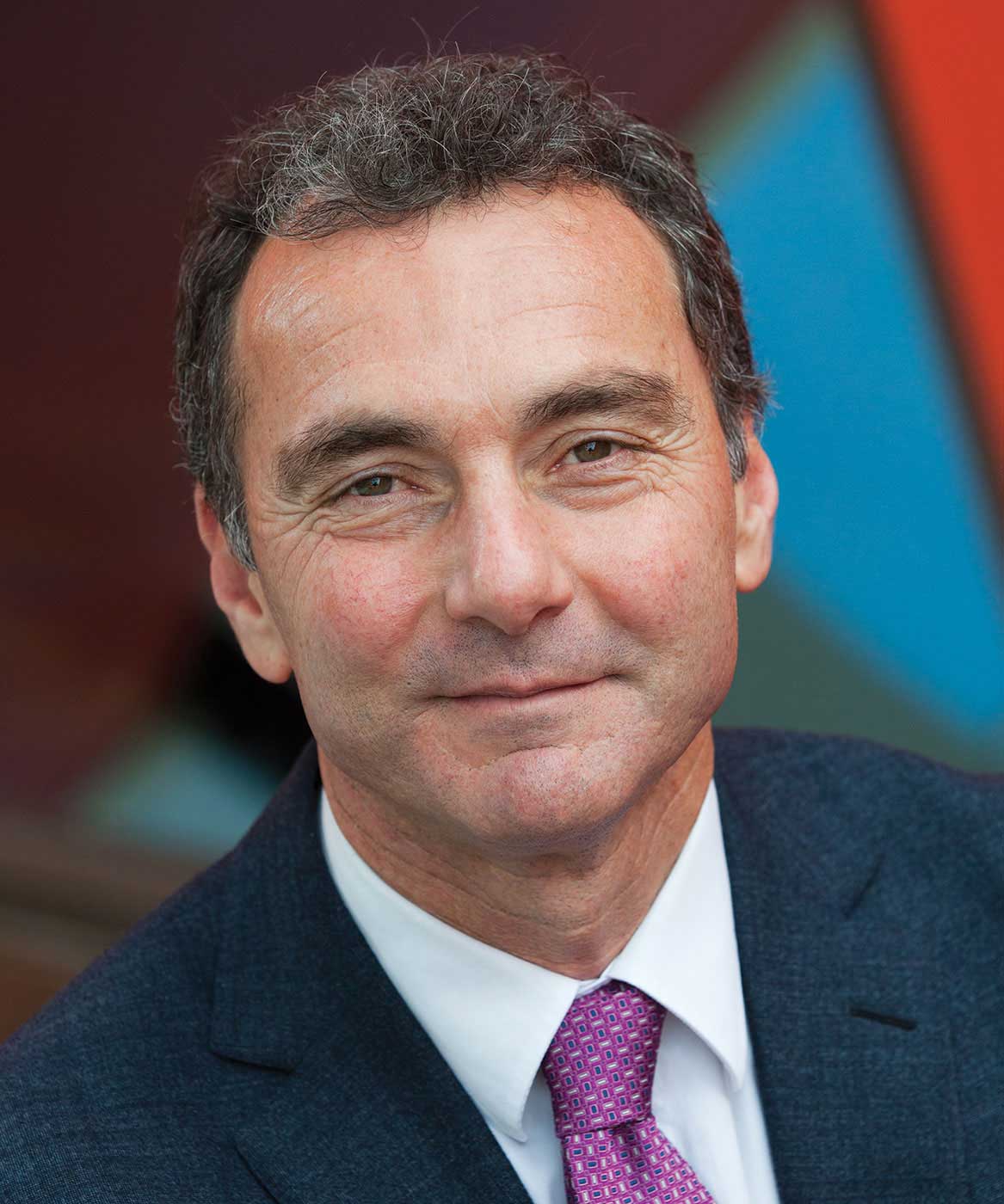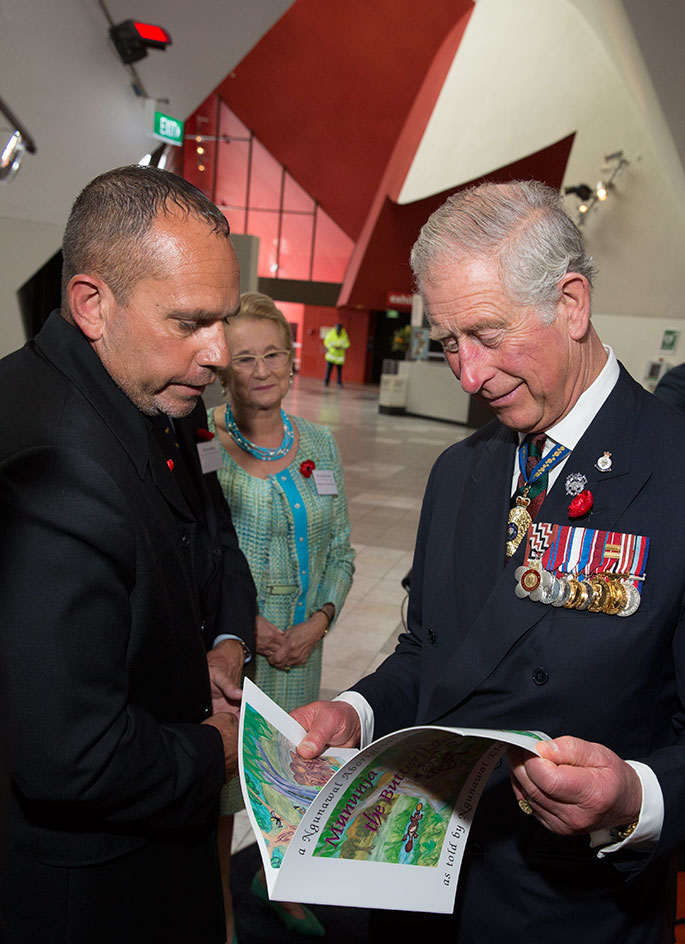
This year saw the National Museum of Australia win public praise and professional awards for its successful exhibition and multimedia programs and the strength of its international engagement. The Museum’s growing presence in, and embrace of, important national conversations has placed it at the forefront of public discussion on a range of compelling topics. In particular, the Museum’s major exhibition, Encounters: Revealing Stories of Aboriginal and Torres Strait Islander Objects from the British Museum, and the related exhibition, Unsettled: Stories within, were acclaimed by audiences and critics alike. Encounters and Unsettled were commended for the quality of their presentation and the collaborative nature of each project.
The Museum was honoured to welcome the Governor-General, His Excellency General Sir Peter Cosgrove, Lady Cosgrove and the Minister for the Arts, Senator the Hon Mitch Fifield, to the Museum for the gala opening of the two exhibitions. Distinguished guests included representatives from many of the Indigenous communities who contributed to the Encounters and Unsettled exhibitions. The success of the exhibitions — which saw the Museum win a major Museums Australia award for Encounters — was testament to the commitment and support of the 27 Aboriginal and Torres Strait Islander communities who were with us every step of the way. The Museum offers its deep thanks to the British Museum, and the communities involved, for their faith and belief in the Encounters partnership, which has stimulated an important national conversation about the role of museums and their responsibilities to Indigenous communities.
In a related event, the Museum launched its new Encounters Indigenous Cultural Workers Scholarships program, during a visit by His Royal Highness, The Prince of Wales, patron of the Encounters exhibition. His Royal Highness, in the company of Senator Fifield, met with Aboriginal and Torres Strait Islander artists whose work featured in the exhibition, and chatted with other guests at a special reception on 11 November 2015. The scholarships, to support the development of Indigenous cultural workers in regional and remote Indigenous communities, are the result of a partnership between the Museum and The Prince’s Charities Australia. The Chairman of The Prince’s Charities Australia, Mr Tony Beddison AO, and the Chief Executive, Ms Janine Kirk AM, were also present for the announcement.
Other exhibitions in the course of the year, including The Home Front: Australia during the First World War, Kaninjaku: Stories from the Canning Stock Route, ACO Virtual, Australian of the Year Awards 2016, and Happy Birthday Play School: Celebrating 50 Years, all helped drive a 23 per cent increase in visitor engagement at the Museum in Canberra over the previous year. Our national touring exhibition program, including Warakurna: All the Stories Got into our Minds and Eyes, Australian of the Year Awards 2015 and Freewheeling: Cycling in Australia, and international displays and exhibitions all contributed to strong offsite visitation of more than 500,000 people over the course of the year. Together with online visitors, this represented a total of more than 3.14 million visitor engagements with the Museum and its programs during 2015–16.
The Museum’s commitment to discussion and debate is evidenced in the continuing relevance and success of our Defining Moments in Australian History project, which seeks to involve all Australians in the selection of key events and issues in Australian history, through the creation of online content and social media posts, and allied displays, events and public forums. Central to the project are the public contributions to a growing list of events that have mattered in our history. This is not just a view of the past produced ‘for’ audiences, but history in which Australians are actively — and productively — engaged.
Several important public discussions were held in partnership with the Australian Broadcasting Corporation’s Radio National, linked to our exhibitions and program themes. Big Ideas presenter Paul Barclay hosted two public panel discussions that focused on the Defining Moments theme, commencing with an event in September 2015 where leading Australian thinkers discussed what makes a ‘defining moment’ in Australian history and how the nation has been shaped by such events. For the second event, Australian of the Year 2015, Rosie Batty, joined ABC journalist Sarah Ferguson in a conversation about giving a voice to victims of family violence and what it meant to be Australian of the Year. An international conference, New Encounters: Communities, Collections and Museums, in March 2016, brought speakers together from Australia, New Zealand, the United States, Canada, the United Kingdom, Denmark, Norway and Finland to discuss and debate issues related to the Encounters exhibition, and well-known ABC broadcaster Geraldine Doogue hosted a panel discussion exploring ‘how encounters can change the world in which we live’.
The Museum’s programming for schools and the general public also drew record numbers, with more than 150,000 participants enjoying the varied offerings of the Museum. The annual Australia Day festival again drew a large family audience. Associated concerts and events, including our popular Night at the Museum program, ensured the Museum added to its reputation as a dynamic venue. Our new interactive multimedia experience for children, Kspace, was successfully launched in October and has already won rave reviews and awards, including a silver MUSE award from the American Alliance of Museums. The Museum also developed an important online resource for schools based on the Encounters exhibition, with the generous support of the Sidney Myer Fund. These curriculum materials encourage teachers and students to engage with the content and materials assembled for the exhibition, and to consider the issues they raise about the history of our nation, and the cultures and experiences of Australia’s first peoples.
International connections and linkages continued to develop during the year. The Museum now has a host of international partnership agreements in place with leading international cultural institutions, and our international program takes great Australian stories to the world. During 2015–16, the Museum entered into a new memorandum of understanding (MoU) with the National Heritage Board of Singapore, completed a collaborative development project under our MoU with the Papua New Guinea National Museum and Art Gallery, and delivered a series of projects and activities as part of our ongoing partnerships with the National Museum of China, the Muséum d’histoire naturelle du Havre and the British Museum. In June 2016, I was also honoured to open the Museum’s touring exhibition, One Road: Aboriginal Art from Australia’s Deserts, at the National Museum of Ethnology, Osaka, Japan. These efforts were recognised when the Museum was named as the 2016 winner of ICOM Australia’s award for the leading Australian organisation contributing to international engagement and dialogue.
This year, the Museum has invested significant time and effort into six major research projects supported by Australian Research Council (ARC) grants with partner organisations, as well as continuing to foster formal and informal research partnerships across Australia and internationally. An important new ARC grant announced this year is ‘Understanding Australia in the age of humans: Localising the Anthropocene’, in which senior curators from the Museum’s People and the Environment team have partnered with researchers from the University of Sydney, the Australian National University (ANU) and the University of New South Wales. The Museum has also won a second major ARC grant, together with the ANU and the British Museum, to continue the research work established in connection with the Encounters project.
The National Historical Collection continues to grow, with acquisitions that speak to aspects of our history and experience as a national community. New acquisitions include works by artists Julie Gough, Wukun Wanambi and Judy Watson that featured in the Unsettled exhibition. The Museum also made a successful bid for the historic 1968 Olympics singlet worn by Australian silver medallist Peter Norman,best known for being ‘the white guy’ on the podium next to gold and bronze medallists Tommie Smith and John Carlos as they raised their fists in a famous protest against racial discrimination in the United States. Another chapter of Australia’s sporting history is captured in the Royce Hart collection, which documents his stellar Australian Rules football career at Richmond Football Club from 1966 to 1977. Perhaps the most unusual addition to our collection this year was the fleece shorn from ‘Chris the Sheep’, which weighed in at 41.1 kilograms, a new world record.
None of the Museum’s achievements in the past year would have been possible without the commitment and support of the staff and volunteers of the organisation. Time and again, they have demonstrated initiative and creativity in pursuit of organisational goals, in a sometimes difficult and challenging economic environment. The Museum has responded to budget tightening by reviewing business processes and exploring savings measures to promote efficiencies and develop more cost-effective ways to fulfill our legislative responsibilities. The Museum continues to invest in staff training and development programs, and has undertaken workforce-planning to prepare for future changes in staffing and resource needs. Two key focus areas for this year have been developing new forms of engagement in the digital sphere, and a fresh approach to developing a sustainable revenue base through a combination of commercial activity and philanthropic engagement. With the implementation of key appointments and organisational changes to support these ambitions, including the establishment of a new associate division, Visitor Services and Development, the Museum has embarked confidently and purposefully to pursue its new growth and development strategies. Once again, the staff and volunteers have enjoyed the great support and encouragement of the Council of the National Museum of Australia, which has been ready throughout the year both to challenge and commend the organisation on its programs and results. The Museum has also farewelled Council members Mr Nicholas Davie, Professor Rae Frances and Mr Peter Yu, each of whom finished their second terms on Council and made exceptional contributions to the life of the Museum. Mr Yu was also the inaugural Chair of the Museum’s Indigenous Reference Group, which played a pivotal role in guiding and advising the Museum throughout the development of the Encounters project.
The Museum also thanks the staff of the Department of Communications and the Arts; the Minister for the Arts, Senator the Hon Mitch Fifield; and the former Minister for the Arts, Senator the Hon George Brandis QC for their great help and assistance throughout the year. The Museum is also deeply grateful to the Friends of the Museum, who are committed to the life of the organisation, and provide great support and advocacy on our behalf. We owe them and our visitors a debt of gratitude for their continued interest and belief in the Museum and its work.
Finally, the Council and staff of the National Museum of Australia were greatly saddened when former director, Mr Andrew Sayers AM, passed away in the course of the year. Mr Sayers made an important and enduring contribution to the Museum during his time as director, from 2010 to 2013, and to the wider cultural life of the nation’s capital, as a senior member of staff at the National Gallery of Australia and founding director of the National Portrait Gallery.
Our thoughts remain with his family.
Dr Mathew Trinca
Director, National Museum of Australia
August 2016
